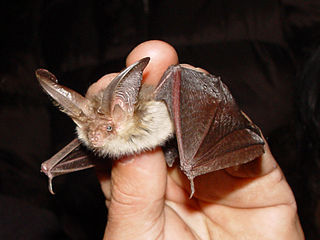
Vespertilionidae is a family of microbats, of the order Chiroptera, flying, insect-eating mammals variously described as the common, vesper, or simple nosed bats. The vespertilionid family is the most diverse and widely distributed of bat families, specialised in many forms to occupy a range of habitats and ecological circumstances, and it is frequently observed or the subject of research. The facial features of the species are often simple, as they mainly rely on vocally emitted echolocation. The tails of the species are enclosed by the lower flight membranes between the legs. Over 300 species are distributed all over the world, on every continent except Antarctica. It owes its name to the genus Vespertilio, which takes its name from a word for bat, vespertilio, derived from the Latin term vesper meaning 'evening'; they are termed "evening bats" and were once referred to as "evening birds".

Plecotus is a genus of vesper bat, commonly called long-eared bats. They are found throughout Eurasia and northern Africa. Many species in the genus have only been described and recognized in recent years.

The Alpine long-eared bat or mountain long-eared bat is a species of long-eared bat. It was originally described from Switzerland and Austria as a species intermediate between the brown long-eared bat and the grey long-eared bat in 1965. It was later described in 2002, from France and Austria, respectively. Despite its name, this species is not restricted to the Alps, being found in Croatia, Bosnia and Herzegovina and elsewhere. It differs from other European long-eared bats, such as the brown long-eared bat, by its white underparts.

The desert long-eared bat is a species of vesper bat found in North Africa and the Middle East.
Christie's long-eared bat, also known as the Egyptian long-eared bat, Christie's big-eared bat, or gray long-eared bat, is a species of vesper bat in the family Vespertilionidae. It is known from North Africa and the Middle East. Its natural habitats are subtropical or tropical dry shrubland, rocky areas, and hot deserts.

The eastern long-eared bat, species Nyctophilus bifax, is a small flying mammal, a vespertilionid bat. It is found in eastern Australia and Papua New Guinea.

The small-toothed long-eared bat is a species of vespertilionid bat found only in Papua New Guinea.
Scott's mouse-eared bat is a species of vesper bat. It is found only in Ethiopia, in subtropical or tropical moist montane forests and shrubland. It is threatened by habitat loss.

Grandidier's trident bat is a species of bat in the family Hipposideridae endemic to Madagascar. It was formerly assigned to the genus Triaenops, but is now placed in the separate genus Paratriaenops.

The Vespertilioninae are a subfamily of vesper bats from the family Vespertilionidae.

The Mediterranean long-eared bat, also known as Kolombatovic's long-eared bat, is a species of vesper bat ranging from Italy east through the Balkans east to Syria, and south to Jordan.
The Turkestani long-eared bat is a species of bat found in Asia. Though it was initially described in 1873 as a species, for many years it was considered synonymous with the desert long-eared bat, Otonycteris hemprichii. Recently, it was recognized as a distinct species once again.

Thomas's big-eared brown bat is a species of vesper bat found in South America.

Gaisler's long-eared bat is a species of bat in the genus Plecotus. It is a medium-sized grayish-brown and found in Morocco, Algeria, Libya, and Tunisia.

Plecotini is a tribe of bats in the family Vespertilionidae. It contains several genera found throughout the Northern Hemisphere, in Eurasia, North Africa, and North America. Several genera in this tribe are known as big-eared bats or long-eared bats. It also contains the spotted bat and barbastelles.
Kozlov's long-eared bat is a species of vesper bat in the family Vespertilionidae. It is found in southern Mongolia and adjacent parts of China.
Strelkov's long-eared bat is a species of vesper bat found in mountainous regions of Central Asia.
Ward's long-eared bat is a species of vesper bat in the family Vespertilionidae. It is found in mountainous regions of South Asia and adjoining regions.












